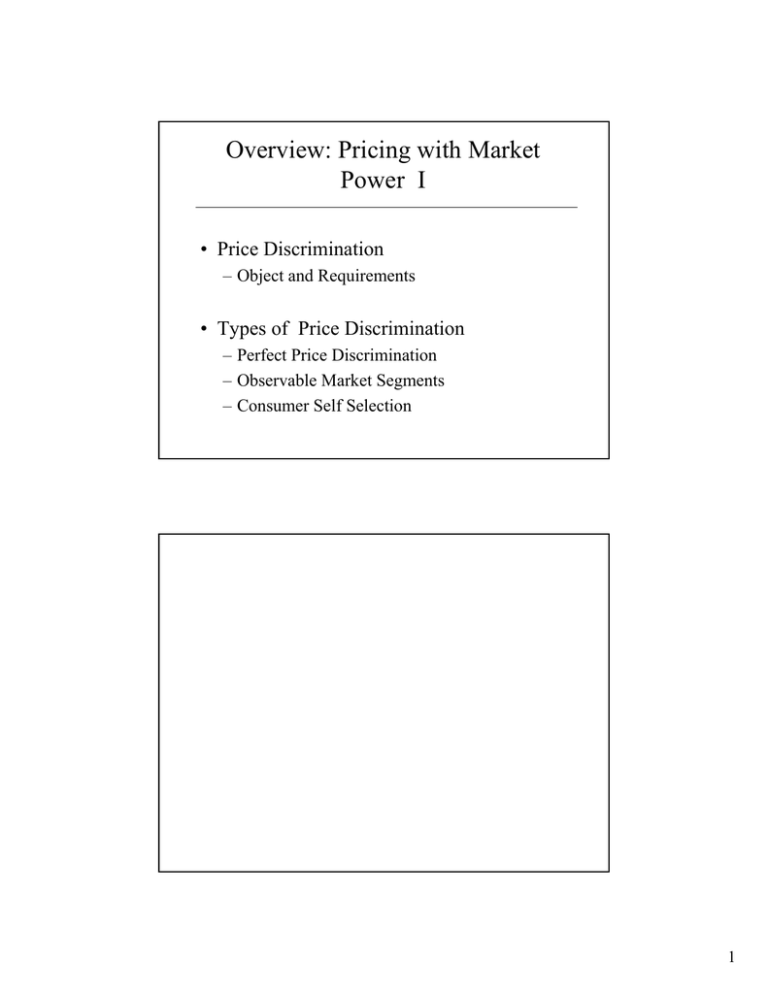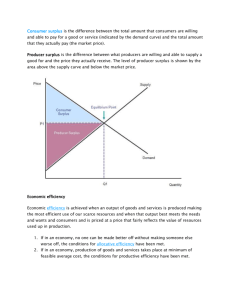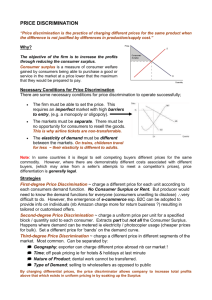Overview: Pricing with Market Power I • Price Discrimination
advertisement

Overview: Pricing with Market Power I • Price Discrimination – Object and Requirements • Types of Price Discrimination – Perfect Price Discrimination – Observable Market Segments – Consumer Self Selection 1 The Monopoly Picture (again) 120 100 Demand 80 MR MR=MC 60 55 40 20 MC=AC c 0 0 20 40 45 60 80 c 100 120 Price Discrimination • Idea: Capture Consumer Surplus as Profits • Some Considerations: – May be seen as unfair – May be seen as anti-competitive (illegal in some B2B transactions : Robinson-Patman Act discussed later) – But may be necessary for viability of some products – Discounts for people who would otherwise not buy – Often improves efficiency 2 Requirements for Price Discrimination • Market power • Resale must be difficult • Knowledge of consumers’ preferences Types of Price Discrimination • Perfect Price Discrimination (Customized Pricing) • Pricing to Observable Market Segments • Consumer Self-Selection 3 Perfect Price Discrimination • Charge reservation price for each unit = price at each P=P(Q) (each point on Demand) • Producer captures all consumer surplus. (No deadweight loss.) • Difficult to capture all surplus in practice • Examples Observable Market Segments • Price by identifiable customer group:Age,... Q1 Revenue R1(Q1) Q2 Revenue R2(Q2) Production: Cost C(Q1 + Q2) • Profits = R1(Q1) + R2(Q2) - C(Q1+Q2) – Choose Q1 and Q2 to maximize profits, I.e. • MR1 = MC • MR2 = MC – So • MR1= MC = MR2 4 Observable Market Segments - II • Charge higher prices to less elastic consumers With R1(Q1) = P1(Q1) Q1; R2(Q2) = P2(Q2) Q2 • MR1 = P1 ( 1 + 1/ε1) • MR2 = P2 (1 + 1/ε2) • MC = MR1=MR 2 => P2 / P1 = (1 + 1/ε1) / (1 + 1/ε2) • When MC constant: Price Price P1 D MC P2 D MR Q1* Quantity Q2* MR Quantity 5 Pricing to Segments in Practice • How can it be done? – Identify (easily verifiable) groups with different elasticities • Examples 6 Consumer Self Selection • Get groups to self-identify by product choice • Examples Consumer Self Selection • All consumers get same menu : price as function of product characteristics (quality, features, quantity) • Menu designed to get high-valuation (low elasticity) consumers to reveal themselves • Typical menu imposes some cost or inconvenience on cheap alternatives 7 Pricing and Inconvenience Price High Valuation Consumers Low Valuation Consumers Inconvenience Guidelines for Menu Choice • Problems the firm faces – People with high valuations want to pretend to be low valuation people and keep some surplus. – If too much surplus is extracted from either group, they won’t buy the good at all. • Solutions – Make high valuation people just prefer the high price choice designed for them rather than the low price option. – Make low valuation people just indifferent between consuming and not consuming. 8 Take Away Points • Price discrimination : capture more consumer surplus than uniform (single) pricing – Make consumers with higher valuations pay more (i.e. capture consumer surplus) – Get consumers with low valuations to buy through (implicit) discounts (i.e. capture deadweight loss) • Perfect price discrimination: charge the reservation price for each unit sold (if you know it ...). • Segmentation: charge low prices to more elastic markets and high prices to less elastic markets. • Self-selection: make consumers identify themselves as having high or low valuations (through e.g. inconvenience) and charge accordingly. 9




